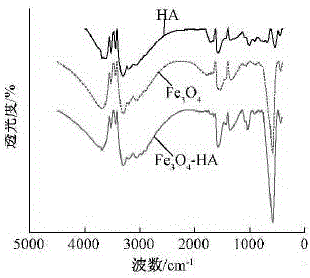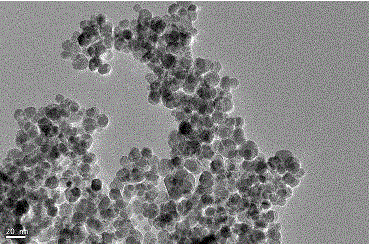Method for preparing magnetic adsorbent for methylene blue wastewater treatment
A magnetic adsorbent, wastewater treatment technology, applied in textile industry wastewater treatment, water/sewage treatment, adsorbed water/sewage treatment, etc., to achieve the effect of good adsorption effect and simple preparation method
- Summary
- Abstract
- Description
- Claims
- Application Information
AI Technical Summary
Problems solved by technology
Method used
Image
Examples
Embodiment 1
[0027] Embodiment 1 A kind of preparation method for the magnetic adsorbent in methylene blue wastewater treatment comprises the following steps:
[0028] ⑴ FeSO 4 ·7H 2 O and FeCl 3 ·6H 2 O was mixed at a mass ratio of 1:1.2 (g / g), dissolved in deionized water that was 8 times the mass of the mixture, and heated to 85°C, and then sequentially added ammonia water with a mass concentration of 25% and a mass concentration of 1% Sodium humate solution, stirred mechanically at 85°C for 30min, cooled to room temperature, and obtained humic acid-modified nano-Fe 3 o 4 Dispersions.
[0029] Among them: the volume ratio (mL / mL) of ammonia water to deionized water is 1:4; the volume ratio (mL / mL) of sodium humate solution to deionized water is 1:1.5.
[0030] (2) Nano-Fe modified by humic acid 3 o 4 The dispersion is magnetically separated with a permanent magnet, and the supernatant is removed to obtain humic acid-modified nano-Fe 3 o 4 .
[0031] (3) Nano-Fe modified by hu...
Embodiment 2
[0032] Embodiment 2 A kind of preparation method for the magnetic adsorbent in methylene blue wastewater treatment comprises the following steps:
[0033] ⑴ FeSO 4 ·7H 2 O and FeCl 3 ·6H 2 O was mixed at a mass ratio of 1:1.8 (g / g), dissolved in deionized water 15 times the mass of the mixture, and heated to 95°C, and then sequentially added ammonia water with a mass concentration of 25% and a mass concentration of 1% Sodium humate solution, mechanically stirred at 95°C for 50min, and cooled to room temperature to obtain humic acid-modified nano-Fe 3 o 4 Dispersions.
[0034] Among them: the volume ratio (mL / mL) of ammonia water to deionized water is 1:8; the volume ratio (mL / mL) of sodium humate solution to deionized water is 1:3.
[0035] (2) Nano-Fe modified by humic acid 3 o 4 The dispersion is magnetically separated with a permanent magnet, and the supernatant is removed to obtain humic acid-modified nano-Fe 3 o 4 .
[0036] (3) Nano-Fe modified by humic acid ...
Embodiment 3
[0037] Embodiment 3 A kind of preparation method for the magnetic adsorbent in methylene blue wastewater treatment comprises the following steps:
[0038] ⑴ FeSO 4 ·7H 2 O and FeCl 3 ·6H 2 O was mixed at a mass ratio of 1:1.5 (g / g), dissolved in deionized water 12 times the mass of the mixture, and heated to 90°C, then sequentially added ammonia water with a mass concentration of 25% and a mass concentration of 1% Sodium humate solution, mechanically stirred at 90°C for 40min, and cooled to room temperature to obtain humic acid-modified nano-Fe 3 o 4 Dispersions.
[0039] Among them: the volume ratio (mL / mL) of ammonia water to deionized water is 1:6; the volume ratio (mL / mL) of sodium humate solution to deionized water is 1:2.5.
[0040] (2) Nano-Fe modified by humic acid 3 o 4 The dispersion is magnetically separated with a permanent magnet, and the supernatant is removed to obtain humic acid-modified nano-Fe 3 o 4 .
[0041] (3) Nano-Fe modified by humic acid 3 ...
PUM
 Login to View More
Login to View More Abstract
Description
Claims
Application Information
 Login to View More
Login to View More - R&D
- Intellectual Property
- Life Sciences
- Materials
- Tech Scout
- Unparalleled Data Quality
- Higher Quality Content
- 60% Fewer Hallucinations
Browse by: Latest US Patents, China's latest patents, Technical Efficacy Thesaurus, Application Domain, Technology Topic, Popular Technical Reports.
© 2025 PatSnap. All rights reserved.Legal|Privacy policy|Modern Slavery Act Transparency Statement|Sitemap|About US| Contact US: help@patsnap.com



